Jianlong Fu
CogACT: A Foundational Vision-Language-Action Model for Synergizing Cognition and Action in Robotic Manipulation
Nov 29, 2024



Abstract:The advancement of large Vision-Language-Action (VLA) models has significantly improved robotic manipulation in terms of language-guided task execution and generalization to unseen scenarios. While existing VLAs adapted from pretrained large Vision-Language-Models (VLM) have demonstrated promising generalizability, their task performance is still unsatisfactory as indicated by the low tasks success rates in different environments. In this paper, we present a new advanced VLA architecture derived from VLM. Unlike previous works that directly repurpose VLM for action prediction by simple action quantization, we propose a omponentized VLA architecture that has a specialized action module conditioned on VLM output. We systematically study the design of the action module and demonstrates the strong performance enhancement with diffusion action transformers for action sequence modeling, as well as their favorable scaling behaviors. We also conduct comprehensive experiments and ablation studies to evaluate the efficacy of our models with varied designs. The evaluation on 5 robot embodiments in simulation and real work shows that our model not only significantly surpasses existing VLAs in task performance and but also exhibits remarkable adaptation to new robots and generalization to unseen objects and backgrounds. It exceeds the average success rates of OpenVLA which has similar model size (7B) with ours by over 35% in simulated evaluation and 55% in real robot experiments. It also outperforms the large RT-2-X model (55B) by 18% absolute success rates in simulation. Code and models can be found on our project page (https://cogact.github.io/).
PromptFix: You Prompt and We Fix the Photo
May 27, 2024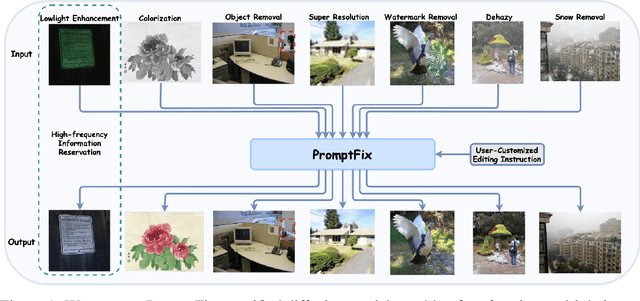
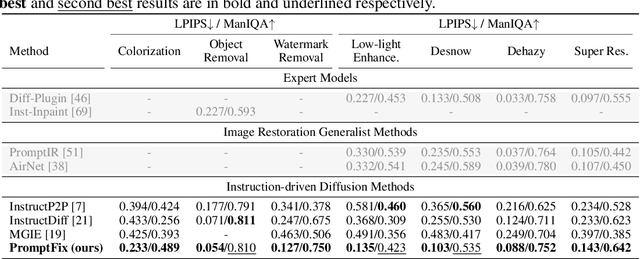
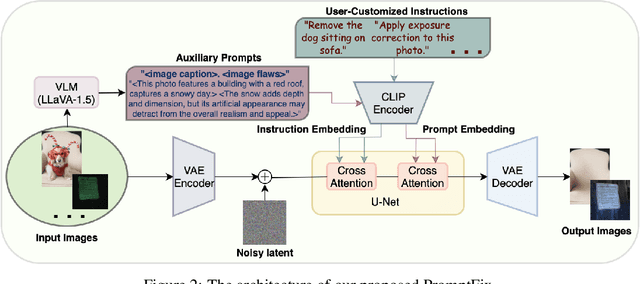

Abstract:Diffusion models equipped with language models demonstrate excellent controllability in image generation tasks, allowing image processing to adhere to human instructions. However, the lack of diverse instruction-following data hampers the development of models that effectively recognize and execute user-customized instructions, particularly in low-level tasks. Moreover, the stochastic nature of the diffusion process leads to deficiencies in image generation or editing tasks that require the detailed preservation of the generated images. To address these limitations, we propose PromptFix, a comprehensive framework that enables diffusion models to follow human instructions to perform a wide variety of image-processing tasks. First, we construct a large-scale instruction-following dataset that covers comprehensive image-processing tasks, including low-level tasks, image editing, and object creation. Next, we propose a high-frequency guidance sampling method to explicitly control the denoising process and preserve high-frequency details in unprocessed areas. Finally, we design an auxiliary prompting adapter, utilizing Vision-Language Models (VLMs) to enhance text prompts and improve the model's task generalization. Experimental results show that PromptFix outperforms previous methods in various image-processing tasks. Our proposed model also achieves comparable inference efficiency with these baseline models and exhibits superior zero-shot capabilities in blind restoration and combination tasks. The dataset and code will be aviliable at https://github.com/yeates/PromptFix.
Zero-Reference Low-Light Enhancement via Physical Quadruple Priors
Mar 19, 2024



Abstract:Understanding illumination and reducing the need for supervision pose a significant challenge in low-light enhancement. Current approaches are highly sensitive to data usage during training and illumination-specific hyper-parameters, limiting their ability to handle unseen scenarios. In this paper, we propose a new zero-reference low-light enhancement framework trainable solely with normal light images. To accomplish this, we devise an illumination-invariant prior inspired by the theory of physical light transfer. This prior serves as the bridge between normal and low-light images. Then, we develop a prior-to-image framework trained without low-light data. During testing, this framework is able to restore our illumination-invariant prior back to images, automatically achieving low-light enhancement. Within this framework, we leverage a pretrained generative diffusion model for model ability, introduce a bypass decoder to handle detail distortion, as well as offer a lightweight version for practicality. Extensive experiments demonstrate our framework's superiority in various scenarios as well as good interpretability, robustness, and efficiency. Code is available on our project homepage: http://daooshee.github.io/QuadPrior-Website/
Spatiotemporal Predictive Pre-training for Robotic Motor Control
Mar 14, 2024Abstract:Robotic motor control necessitates the ability to predict the dynamics of environments and interaction objects. However, advanced self-supervised pre-trained visual representations (PVRs) in robotic motor control, leveraging large-scale egocentric videos, often focus solely on learning the static content features of sampled image frames. This neglects the crucial temporal motion clues in human video data, which implicitly contain key knowledge about sequential interacting and manipulating with the environments and objects. In this paper, we present a simple yet effective robotic motor control visual pre-training framework that jointly performs spatiotemporal predictive learning utilizing large-scale video data, termed as STP. Our STP samples paired frames from video clips. It adheres to two key designs in a multi-task learning manner. First, we perform spatial prediction on the masked current frame for learning content features. Second, we utilize the future frame with an extremely high masking ratio as a condition, based on the masked current frame, to conduct temporal prediction of future frame for capturing motion features. These efficient designs ensure that our representation focusing on motion information while capturing spatial details. We carry out the largest-scale evaluation of PVRs for robotic motor control to date, which encompasses 21 tasks within a real-world Franka robot arm and 5 simulated environments. Extensive experiments demonstrate the effectiveness of STP as well as unleash its generality and data efficiency by further post-pre-training and hybrid pre-training.
Multi-task Manipulation Policy Modeling with Visuomotor Latent Diffusion
Mar 12, 2024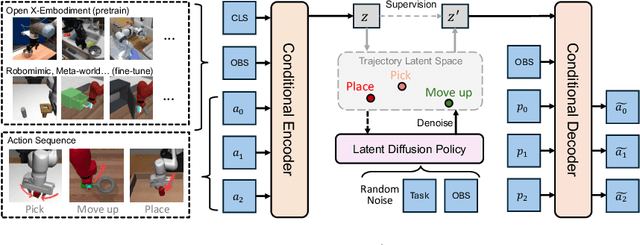
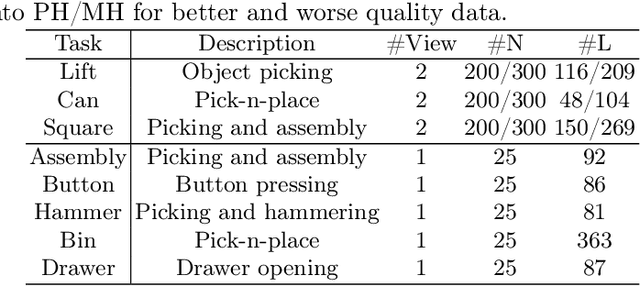
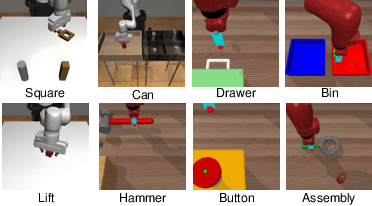
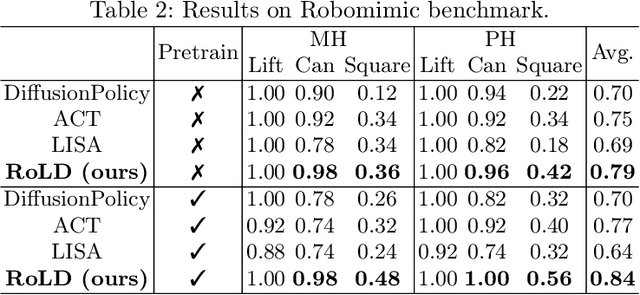
Abstract:Modeling a generalized visuomotor policy has been a longstanding challenge for both computer vision and robotics communities. Existing approaches often fail to efficiently leverage cross-dataset resources or rely on heavy Vision-Language models, which require substantial computational resources, thereby limiting their multi-task performance and application potential. In this paper, we introduce a novel paradigm that effectively utilizes latent modeling of manipulation skills and an efficient visuomotor latent diffusion policy, which enhances the utilizing of existing cross-embodiment and cross-environment datasets, thereby improving multi-task capabilities. Our methodology consists of two decoupled phases: action modeling and policy modeling. Firstly, we introduce a task-agnostic, embodiment-aware trajectory latent autoencoder for unified action skills modeling. This step condenses action data and observation into a condensed latent space, effectively benefiting from large-scale cross-datasets. Secondly, we propose to use a visuomotor latent diffusion policy that recovers target skill latent from noises for effective task execution. We conducted extensive experiments on two widely used benchmarks, and the results demonstrate the effectiveness of our proposed paradigms on multi-tasking and pre-training. Code is available at https://github.com/AlbertTan404/RoLD.
Learning Position-Aware Implicit Neural Network for Real-World Face Inpainting
Jan 19, 2024Abstract:Face inpainting requires the model to have a precise global understanding of the facial position structure. Benefiting from the powerful capabilities of deep learning backbones, recent works in face inpainting have achieved decent performance in ideal setting (square shape with $512px$). However, existing methods often produce a visually unpleasant result, especially in the position-sensitive details (e.g., eyes and nose), when directly applied to arbitrary-shaped images in real-world scenarios. The visually unpleasant position-sensitive details indicate the shortcomings of existing methods in terms of position information processing capability. In this paper, we propose an \textbf{I}mplicit \textbf{N}eural \textbf{I}npainting \textbf{N}etwork (IN$^2$) to handle arbitrary-shape face images in real-world scenarios by explicit modeling for position information. Specifically, a downsample processing encoder is proposed to reduce information loss while obtaining the global semantic feature. A neighbor hybrid attention block is proposed with a hybrid attention mechanism to improve the facial understanding ability of the model without restricting the shape of the input. Finally, an implicit neural pyramid decoder is introduced to explicitly model position information and bridge the gap between low-resolution features and high-resolution output. Extensive experiments demonstrate the superiority of the proposed method in real-world face inpainting task.
ViCo: Engaging Video Comment Generation with Human Preference Rewards
Aug 22, 2023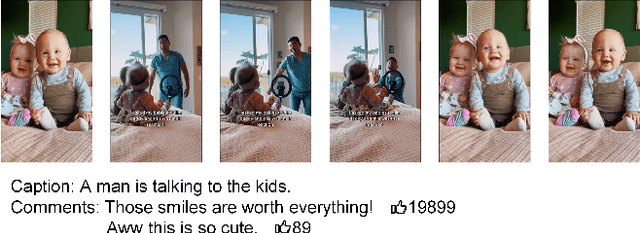

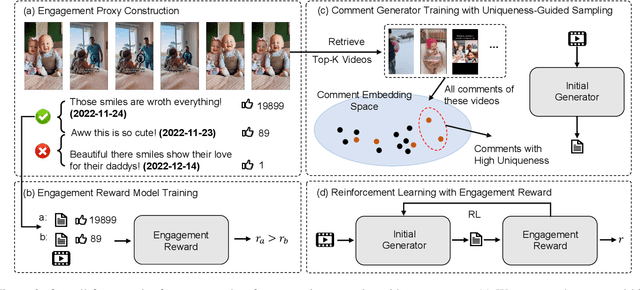

Abstract:Engaging video comments play an important role in video social media, as they are the carrier of feelings, thoughts, or humor of the audience. Preliminary works have made initial exploration for video comment generation by adopting caption-style encoder-decoder models. However, comment generation presents some unique challenges distinct from caption generation, which makes these methods somewhat less effective at generating engaging comments. In contrast to the objective and descriptive nature of captions, comments tend to be inherently subjective, making it hard to quantify and evaluate the engagement of comments. Furthermore, the scarcity of truly engaging comments brings difficulty to collecting enough high-quality training examples. In this paper, we propose ViCo with three novel designs to tackle the above challenges for generating engaging Video Comments. Firstly, to quantify the engagement of comments, we utilize the number of "likes" each comment receives as a proxy of human preference after an appropriate debiasing procedure. Secondly, to automatically evaluate the engagement of comments, we train a reward model to align its judgment to the above proxy. Our user studies indicate that this reward model effectively aligns with human judgments. Lastly, to alleviate the scarcity of high-quality comments, an initial generator is trained on readily available but noisy data to generate comments. Then the reward model is employed to offer feedback on the generated comments, thus optimizing the initial generator. To facilitate the research of video commenting, we collect a large video comment-dataset (ViCo-20k) with rich metadata from a popular video website. Experiments on ViCo-20k show that the comments generated by our ViCo model exhibit the best performance in terms of both quantitative and qualitative results, particularly when engagement is considered.
Improving Diversity in Zero-Shot GAN Adaptation with Semantic Variations
Aug 21, 2023Abstract:Training deep generative models usually requires a large amount of data. To alleviate the data collection cost, the task of zero-shot GAN adaptation aims to reuse well-trained generators to synthesize images of an unseen target domain without any further training samples. Due to the data absence, the textual description of the target domain and the vision-language models, e.g., CLIP, are utilized to effectively guide the generator. However, with only a single representative text feature instead of real images, the synthesized images gradually lose diversity as the model is optimized, which is also known as mode collapse. To tackle the problem, we propose a novel method to find semantic variations of the target text in the CLIP space. Specifically, we explore diverse semantic variations based on the informative text feature of the target domain while regularizing the uncontrolled deviation of the semantic information. With the obtained variations, we design a novel directional moment loss that matches the first and second moments of image and text direction distributions. Moreover, we introduce elastic weight consolidation and a relation consistency loss to effectively preserve valuable content information from the source domain, e.g., appearances. Through extensive experiments, we demonstrate the efficacy of the proposed methods in ensuring sample diversity in various scenarios of zero-shot GAN adaptation. We also conduct ablation studies to validate the effect of each proposed component. Notably, our model achieves a new state-of-the-art on zero-shot GAN adaptation in terms of both diversity and quality.
MobileVidFactory: Automatic Diffusion-Based Social Media Video Generation for Mobile Devices from Text
Jul 31, 2023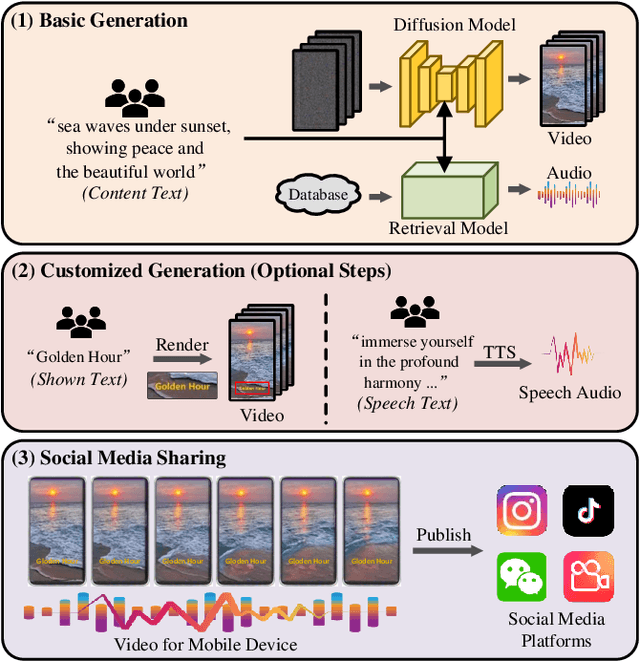
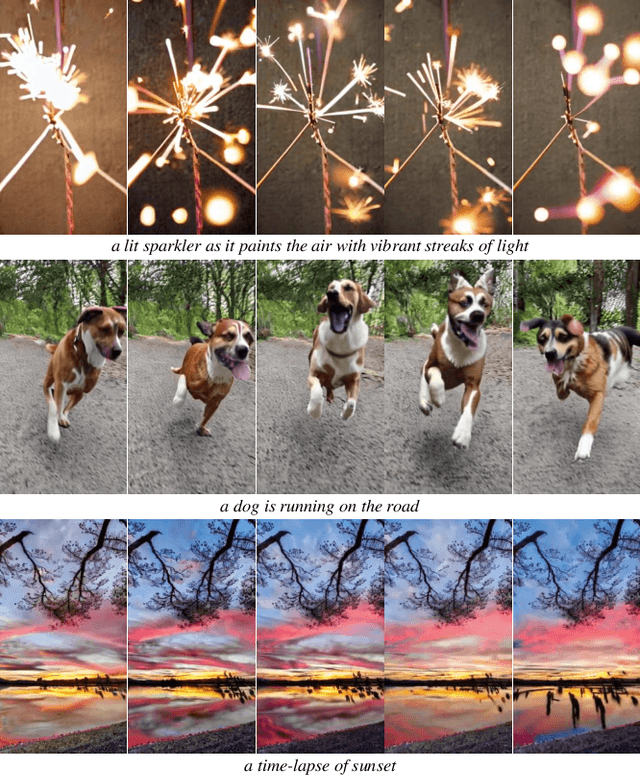
Abstract:Videos for mobile devices become the most popular access to share and acquire information recently. For the convenience of users' creation, in this paper, we present a system, namely MobileVidFactory, to automatically generate vertical mobile videos where users only need to give simple texts mainly. Our system consists of two parts: basic and customized generation. In the basic generation, we take advantage of the pretrained image diffusion model, and adapt it to a high-quality open-domain vertical video generator for mobile devices. As for the audio, by retrieving from our big database, our system matches a suitable background sound for the video. Additionally to produce customized content, our system allows users to add specified screen texts to the video for enriching visual expression, and specify texts for automatic reading with optional voices as they like.
SINC: Self-Supervised In-Context Learning for Vision-Language Tasks
Jul 15, 2023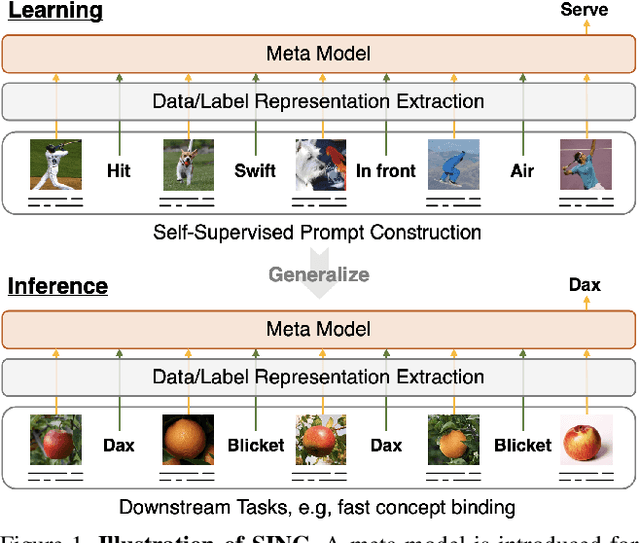
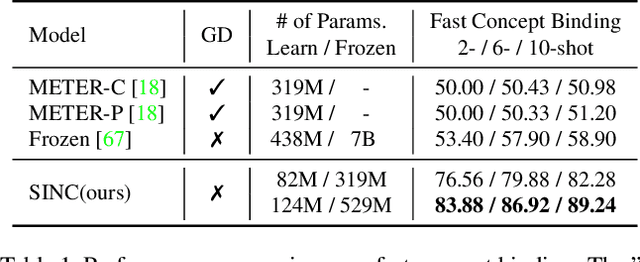
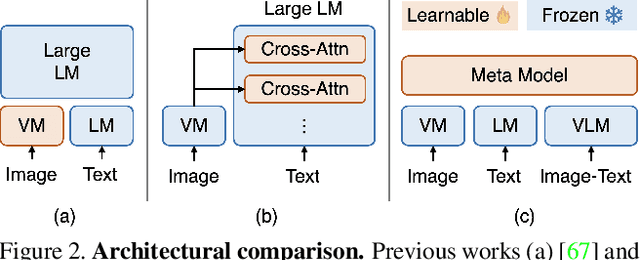

Abstract:Large Pre-trained Transformers exhibit an intriguing capacity for in-context learning. Without gradient updates, these models can rapidly construct new predictors from demonstrations presented in the inputs. Recent works promote this ability in the vision-language domain by incorporating visual information into large language models that can already make in-context predictions. However, these methods could inherit issues in the language domain, such as template sensitivity and hallucination. Also, the scale of these language models raises a significant demand for computations, making learning and operating these models resource-intensive. To this end, we raise a question: ``How can we enable in-context learning for general models without being constrained on large language models?". To answer it, we propose a succinct and general framework, Self-supervised IN-Context learning (SINC), that introduces a meta-model to learn on self-supervised prompts consisting of tailored demonstrations. The learned models can be transferred to downstream tasks for making in-context predictions on-the-fly. Extensive experiments show that SINC outperforms gradient-based methods in various vision-language tasks under few-shot settings. Furthermore, the designs of SINC help us investigate the benefits of in-context learning across different tasks, and the analysis further reveals the essential components for the emergence of in-context learning in the vision-language domain.
 Add to Chrome
Add to Chrome Add to Firefox
Add to Firefox Add to Edge
Add to Edge